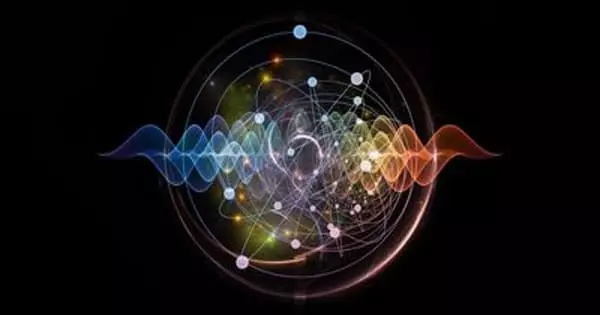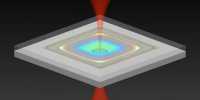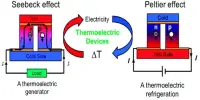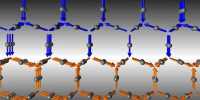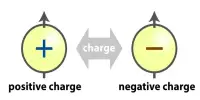Solid-solution organic crystals have been introduced into the search for better photon up-conversion materials, which convert currently wasted long-wavelength light into more useful shorter wavelength light. Scientists from the Tokyo Institute of Technology revisited a previously deemed ineffective materials approach, using a molecule originally developed for organic LEDs, and achieved outstanding performance and efficiency. Their discoveries pave the way for numerous novel photonic technologies, such as improved solar cells and photocatalyst for hydrogen and hydrocarbon production.
Light is a powerful source of energy that, when properly harnessed, can be used to drive difficult chemical reactions, generate electricity, and power optoelectronic devices. However, not all wavelengths of light can be used in most applications. This is because the energy carried by each photon is inversely proportional to its wavelength, and light only triggers chemical and physical processes when the energy provided by individual photons exceeds a certain threshold.
The results of our experiments using simulated sunlight indicate that solar concentration optics such as lenses are no longer required to efficiently upconvert terrestrial sunlight. The proof-of-concept we presented in our paper is a significant technical leap forward in the pursuit of high-performance PUC solids, which will open up diverse photonics technologies in the future.
Yoichi Murakami
This means that devices such as solar cells cannot benefit from all of the color contained in sunlight because it is made up of photons with both high and low energies. Scientists all over the world are working hard to develop materials that will enable photon up-conversion (PUC), a process in which photons with lower energies (longer wavelengths) are captured and re-emitted as photons with higher energies (shorter wavelengths). One promising method is triplet-triplet annihilation (TTA). This process necessitates the use of both a sensitizer and an annihilator material. The sensitizer absorbs low-energy photons (long-wavelength light) and transfers its excited energy to the annihilator, which emits higher energy photons (light of shorter wavelength) as a result of TTA.
For a long time, it has been difficult to find good solid materials for PUC. Although liquid samples can achieve relatively high PUC efficiency, working with liquids, particularly those containing organic solvents, is inherently dangerous and time-consuming in many applications. Previous attempts to create PUC solids, on the other hand, were plagued by poor crystal quality and small crystal domains, resulting in short traveling distances of triplet excited states and, as a result, low PUC efficiency. Furthermore, most previous solid PUC samples were not tested for stability under continuous photo irradiation, and experimental data were frequently collected in inert gas atmospheres. As a result, low efficiency and insufficient material stability have long been a source of concern.
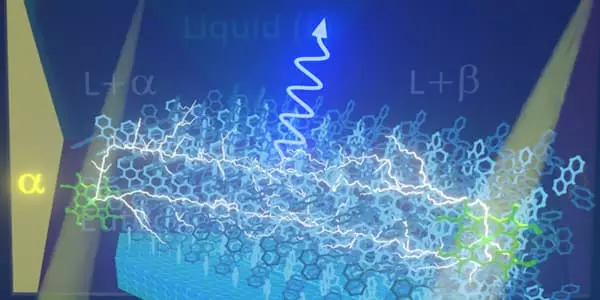
A team of researchers led by Associate Professor Yoichi Murakami of Tokyo Tech, Japan, recently discovered the solution to this challenge. Their paper (open access) is published in Materials Horizon and describes how they focused on van Der Waals crystals, a classical materials class that has not been considered in the search for high-efficiency PUC solids. They tried mixing 9-(2-naphthyl)-10-[4-(1-naphthyl)phenyl]anthracene (ANNP), a hydrocarbon molecule originally developed for blue organic LEDs, with platinum octaethylporphyrin (PtOEP), a staple sensitizer that absorbs green light, after discovering that it was an excellent annihilator for embodying their concept.
The researchers discovered that by using the crystalline phase of a van dar Waals solid solution with a sufficiently low proportion of PtOEP to ANNP, aggregation of the sensitizer molecules could be completely avoided (around 1:50000). They went on to thoroughly characterize the obtained crystals and discovered why using the ANNP annihilator prevented sensitizer aggregation when other existing annihilators had failed in previous studies. Furthermore, as Dr. Murakami points out, the team’s solid crystals were highly stable and performed exceptionally well. “The results of our experiments using simulated sunlight indicate that solar concentration optics such as lenses are no longer required to efficiently upconvert terrestrial sunlight,” he says.
Overall, this study reintroduces van der Waals crystals into the PUC game as an efficient method of producing outstanding solid materials using versatile hydrocarbon annihilators. “The proof-of-concept we presented in our paper is a significant technical leap forward in the pursuit of high-performance PUC solids, which will open up diverse photonics technologies in the future,” Dr. Murakami concludes. Let us hope that future research in this area will allow us to efficiently transform light into its most useful forms.
